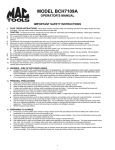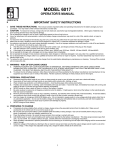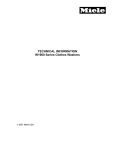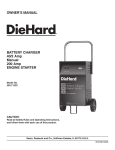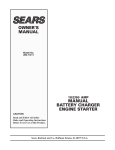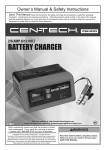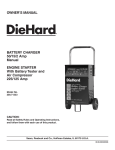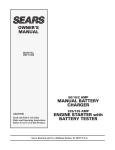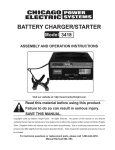Download Associated Equipment BCH7112 User's Manual
Transcript
MODEL BCH7112 OPERATOR'S MANUAL IMPORTANT SAFETY INSTRUCTIONS 1. SAVE THESE INSTRUCTIONS. This manual contains important safety and operating instructions for battery charger Model BCH7112. You may need to refer to these instructions at a later date. 2. CAUTION. To reduce risk of injury, charge only wet cell, lead-acid, automotive type rechargeable batteries. Other types of batteries may burst causing personal injury and damage. Do not expose the charger to rain or snow if specifically warned on the unit not to do so. Use of an attachment not recommended or sold by the battery charger manufacturer may result in a risk of fire, electric shock, or injury to persons. 5. To reduce the risk of damage to the electric plug and cord, pull by the plug rather than the cord when disconnecting the charger. 6. Make sure the cord is located so that it will not be stepped on, tripped over, or otherwise subjected to damage or stress. 7. An extension cord should not be used unless absolutely necessary. Use of a improper extension cord could result in a risk of fire and electric shock. If an extension cord must be used, make sure: a. That the pins on the plug of extension cord are the same number, size, and shape as those of the plug on the charger; b. That the extension cord is properly wired and in good condition; and c. That wire in cord is proper size as follows: Minimum recommended AWG wire size for various length extension cords used with this charger: Length of Cord, Feet 25 50 100 150 AWG Size 18 18 16 14 8. Do not operate the charger with a damaged cord or plug, replace them immediately. 9. Do not operate the charger if it has received a sharp blow, been dropped, or otherwise damaged in any way; take it to a qualified serviceman. 10. Do not disassemble the charger, take it to a qualified serviceman when service or repair is required. Incorrect reassembly may result in risk of electric shock or fire. 11. To reduce the risk of electric shock, unplug the charger form the outlet before attempting any maintenance or cleaning. Turning off the controls will not reduce this risk. 3. 4. 12. WARNING - RISK OF EXPLOSIVE GASES a. WORKING IN VICINITY OF A LEAD-ACID BATTERY IS DANGEROUS. BATTERIES GENERATE EXPLOSIVE GASES DURING NORMAL BATTERY OPERATION. FOR THIS REASON IT IS OF UTMOST IMPORTANCE THAT EACH TIME BEFORE USING YOUR CHARGER, YOU READ THIS MANUAL AND FOLLOW THE INSTRUCTIONS EXACTLY. b. To reduce the risk of battery explosion, follow these instructions and those published by the battery manufacturer and manufacturer of any equipment you intend to use in vicinity of the battery. Review cautionary markings on these products and on the engine. 13. PERSONAL PRECAUTIONS a. Someone should be within range of your voice or close enough to come to your aid when you work near a lead-acid battery. b. Have plenty of fresh water and soap nearby in case battery acid contacts skin, clothing, or eyes. c. Wear complete eye protection, and clothing protection. Avoid touching eyes while working near battery. d. If battery acid contacts skin or clothing, wash immediately with soap and water. If acid enter eyes, immediately flood eyes with running cold water for at least 10 minutes and get medical attention immediately. e. NEVER smoke or allow a spark or flame in vicinity of the battery or engine. f. Be extra cautious to reduce risk of dropping a metal tool onto the battery. It might spark or short circuit the battery or other electrical parts that may cause an explosion. g. Remove personal metal items such as rings, bracelets, necklaces, and watches when working with a lead-acid battery. A lead-acid battery can produce a short circuit current high enough to weld a ring or the like to metal, causing a severe burn. h. Use this charger for charging a LEAD-ACID battery only. It is not intended to supply power to a low-voltage electrical system other than in an automotive application. Do not use this battery charger for charging dry-cell batteries that are commonly used with home appliances. These batteries may burst and cause injury to persons and damage to property. i NEVER charge a frozen battery. 14. PREPARING TO CHARGE a. If necessary to remove battery from vehicle to charge, always remove the grounded terminal from the battery first. Make sure all accessories in the vehicle are off, so as not to cause an arc. b. Be sure the area around the battery is well ventilated while the battery is being charged. Gas can be forcefully blown away by using a piece of cardboard or other non-metallic material as a fan. c. Clean the battery terminals. Be careful to keep corrosion from coming in contact with eyes. d. Add distilled water in each cell until battery acid reaches level specified by the battery manufacturer. This helps purge excessive gas from cells. Do not overfill. For a battery without cell caps, carefully follow the manufacturer's recharging instructions. 1 e. f. Study all battery manufacturer's specific precautions such as removing or not removing the cell caps while charging and the recommended rates of charge. Determine voltage of the battery by referring to the car owner's manual and make sure that the output voltage selector switch is set at the correct voltage. If the charger has adjustable charge rate, charge the battery initially at the lowest rate. 15. CHARGER LOCATION a. Locate the charger as far away from the battery as the DC cables permit. b. Never place the charger directly above the battery being charged; gases from the battery will corrode and damage the charger. c. Never allow battery acid to drip on the charger when reading the specific gravity or filling battery, d. Do not operate the charger in a closed-in area, or restrict ventilation in any way. e. Do not set a battery on top of the charger. OPERATING INSTRUCTIONS CHARGER CONTROLS Charge Selector Switch: Allows for selection of one of three different operations. 1. 12 VOLT - 2 AMP CHARGE: Best for small batteries used in motorcycles, garden tractors, etc. 2 12 VOLT - 10 AMP CHARGE: Charges all larger 12 volt batteries at 10 Amps. Output will drop as charge builds and battery voltage increases. 3. 12 VOLT ENGINE START: - (12 volt electrical systems only) On this setting the charger will provide up to 50 amps additional current to aid in engine starting. Due to the very high currents involved, the charger must be allowed to cool for two to three minutes after ten seconds of steady engine start cranking. CHARGER OVERLOAD PROTECTION The BCH7112 battery charger is protected from power overload by two automatic heat sensing switches. One is in the DC output circuit, the other is built on the transformer. The first will operate when a short circuit, reverse connections, or too long engine cranking, overloads the charger. The protector will open with a click sound and will close in a few seconds. The seconds protector will operate when a prolonged overload due to a defective battery or other excessive load causes the transformer to overheat. It will close after several minutes when the transformer cools. 16. DC CONNECTION PRECAUTIONS a. Connect and disconnect the DC output clamps only after removing the AC cord from the electric outlet. Never allow the clamps to touch each other. b. Attach the DC clamps to the battery post and twist or rock back and forth several times to make a good connection. This tends to keep the clamps from slipping off the terminals and helps to reduce the risk of sparking. 17. FOLLOW THESE STEPS WHEN THE BATTERY IS INSTALLED IN A VEHICLE. A SPARK NEAR THE BATTERY MAY CAUSE A BATTERY EXPLOSION. TO REDUCE THE RISK OF A SPARK NEAR THE BATTERY: a. b. c. d. e. f. g. h. Position the AC and DC cords to reduce the risk of damage by the hood, door, or moving engine parts. Stay clear of fan blades, belts, pulleys, and other parts that can cause injury to persons. Check the polarity of the battery post. The POSITIVE (POS, P, +) battery post usually has a larger diameter than the NEGATIVE (NEG, N, -) post. Determine which post of the battery is grounded (connected) to the chassis. If the negative post is grounded to the chassis (as in most vehicles), see item "e". If the positive post is grounded to the chassis, see item "f". For negative-grounded vehicles, connect the POSITIVE (RED) clamp from the battery charger to the POSITIVE (POS, P, +) ungrounded post of the battery. Connect the NEGATIVE (BLACK) clamp to the vehicle chassis, heavy gauge metal part of the frame, or engine block, away from the battery. Do not connect to the carburetor, fuel lines, or sheet metal body parts. For positive-grounded vehicles, connect the NEGATIVE (BLACK) clamp from the battery charger to the NEGATIVE (NEG, N, -) ungrounded post of the battery. Connect the POSITIVE (RED) clamp to the vehicle chassis or engine away from the battery. Do not connect the clamp to the carburetor, fuel lines, or sheet-metal body parts. Connect to a heavy gauge metal part of the frame or engine block. When disconnecting the charger, disconnect the AC cord, remove the clamp from the vehicle chassis, and then remove the clamp from the battery terminal. See the operating instructions for length of charge information. 18. FOLLOW THESE STEPS WHEN THE BATTERY IS OUTSIDE THE VEHICLE. A SPARK NEAR THE BATTERY MAY CAUSE BATTERY EXPLOSION. TO REDUCE THE RISK OF A SPARK NEAR THE BATTERY: a. b. c. d. e. f. g. Check the polarity of the battery post. The POSITIVE (POS, P, +) usually has a larger diameter than the NEGATIVE (NEG, N, -) post. Attach at least a 24 inch long 6-gauge (AWG) insulated battery cable to the NEGATIVE (NEG, N, -) battery post. Connect the POSITIVE (RED) charger clamp to the POSITIVE (POS, P, +) post of the battery. Position yourself and the free end of the cable as far away from the battery as possible, then connect the NEGATIVE (BLACK) charger clamp to the free end of cable. Do not face the battery when making the final connection. When disconnecting the charger, always do so in reverse sequence of connecting procedure, and break the first connection while standing as far away from the battery as practical. A marine (boat) battery must be removed and charged on shore. To charge it on board requires equipment specially designed for marine use. 19. VEHICLES WITH TWO BATTERIES Many diesel vehicles and service vehicles are equipped with two batteries. This is to provide the vehicle with greater starting power capacity 2 or longer reserve capacity to provide power for accessories. These batteries are wired into a parallel circuit. Because of this, it will take twice as long to charge these batteries. See section 21 CHARGE PERIOD. If one battery is charged and the other discharged, the discharged battery should be removed from the vehicle and checked. When attaching the charger to this type of vehicle the charger should be attached to the battery which is wired closest to the starter. This allows the charger to provide maximum starting power to the starter motor by minimizing the voltage drop in the engine cables. 3 20. GROUNDING AND AC POWER CORD CONNECTION INSTRUCTIONS The charger should be grounded to reduce the risk of electric shock. This charger is equipped with an electric cord having an equipment grounding conductor and a grounding plug. The plug must be plugged into an outlet that is properly installed and grounded in accordance with all local codes and ordinances. DANGER. Never alter the AC cord or plug provided - if it will not fit the outlet, have a proper outlet installed by a qualified electrician. Improper connection can result in a risk of an electric shock. This battery charger is for use on a nominal 120-volt circuit, and has a grounding plug that looks like the plug illustrated in sketch (A). A temporary adapter, which looks like the adapter illustrated in sketch (C), may be used to connect this plug to a two-pole receptacle, as shown in sketch (B), until a properly grounded outlet can be installed by a qualified electrician.DANGER. Before using an adapter as illustrated, be certain that the center screw of the outlet plate is grounded. The green-colored rigid ear or lug extending from the adapter must be connected to a properly grounded outlet - make certain it is grounded. If necessary, replace the original outlet cover plate screw with a longer screw that will secure the adapter ear or lug to the outlet cover plate and make ground connection to grounded outlet. 21. CHARGE PERIOD The approximate required time to bring a battery to full charge state depends upon the number of ampere-hours (AH) depleted from the battery. AH's are determined by multiplying the number of hours times the number of amps supplied by a battery to a load and normally indicated on the battery. For example, if a load was connected to a battery, which drew 7 amps for a period of 5 hours, the battery will have supplied 35 AH. The approximate recharge time would then be calculated by dividing the 35 AH depleted from the battery, by the charge rate of the charger. To allow for tapering of the charge rate add 25 percent to the charge time. POSSIBLE CHARGING PROBLEMS 1. THERMAL OVERLOAD SWITCH (CIRCUIT BREAKER) STARTS CYCLING: a. A battery with shorted cells will cause the circuit breaker to cycle indefinitely. This must not be allowed to continue. b. Reversed charger connections will also cause cycling to continue indefinitely. This must not be allowed to continue. c. If a severely discharged battery is in otherwise good condition, the cycling will stop in 15 to 20 minutes when the battery has developed voltage to allow a normal charging rate. 2. THERE IS NO METER READING: a. Check the AC outlet or extension cord connections, to be sure power is being supplied to the battery charger. b. Check the clamps and terminals for corrosion. c. A very low reading may indicate a defective battery. A badly sulfated battery (a result of remaining discharged for a long period) or in some cases a completely discharged battery may produce this effect. If the charge rate does not increase after three or four hours have the battery checked. 3. THE METER NEEDLE SWINGS TO THE EXTREME RIGHT SIDE OF THE METER. a. Check for reverse polarity connections. b. If the battery is severely discharged, the charge meter needle may start to cycle up and down. This will stop after 15 to 20 minutes. c. The battery may one or more shorted cells. Cycling will start immediately and continue indefinitely. If cycling has not stopped as outlined in (b), disconnect the charger (AC power cord first) and have the battery tested. MAINTENANCE INSTRUCTIONS This charger requires minimal maintenance. As with any appliance or tool, a few common sense rules will prolong the life of the battery charger. ALWAYS BE SURE THE CHARGER IS UNPLUGGED BEFORE DOING ANY MAINTENANCE OR CLEANING. 1. Store in a clean, dry place 2. Coil up the cords when not in use. 3. Clean the case and cords with a slightly damp cloth. 4. Clean any corrosion from the clamps with a solution of water and backing soda. 5. Examine the cords periodically for cracking or other damage and have them replaced if necessary. 4 MODEL BCH7112 LIMITED WARRANTY ASSOCIATED EQUIPMENT CORPORATION MAKES THIS LIMITED WARRANTY TO THE ORIGINAL PURCHASER AT RETAIL OF THIS PRODUCT. THIS WARRANTY IS NOT TRANSFERABLE. Associated Equipment Corporation warrants this battery charger for two years from date of purchase at retail against defective material or workmanship. If such should occur, the unit will be repaired or replaced at the option of the manufacturer. It is the obligation of the purchaser to forward the unit together with proof of purchase, transportation and /or mailing charges prepaid to ASSOCIATED EQUIPMENT CORPORATION, 5110 BROWN AVE., SAINT LOUIS, MISSOURI 63115 This limited warranty is void if the product is misused, subjected to careless handling, or repaired by anyone other than the factory. Associated Equipment Corporation makes no warranty other than this limited warranty and expressly excludes any implied warranty including any warranty for consequential damages. THIS IS THE ONLY EXPRESS LIMITED WARRANTY AND ASSOCIATED EQUIPMENT CORPORATION NEITHER ASSUMES NOR AUTHORIZES ANYONE TO ASSUME OR MAKE ANY OBLIGATION TOWARD THE PRODUCT OTHER THAN THIS EXPRESS LIMITED WARRANTY. ASSOCIATED EQUIPMENT CORPORATION MAKES NO WARRANTY OF MERCHANTABILITY OR FITNESS FOR PURPOSE OF THIS PRODUCT AND EXPRESSLY EXCLUDES SUCH FROM THIS LIMITED WARRANTY. SOME STATES DO NOT ALLOW THE EXCLUSION OR LIMITATION OF INCIDENTAL OR CONSEQUENTIAL DAMAGES OR LENGTH OF IMPLIED WARRANTY SO THE ABOVE LIMITATIONS MAY NOT APPLY TO YOU. THIS WARRANTY GIVES YOU SPECIFIC LEGAL RIGHTS AND YOU MAY ALSO HAVE OTHER RIGHTS WHICH VARY FROM STATE TO STATE. 5 ASSOCIATED EQUIPMENT CORPORATION 5110 BROWN AVE. ST. LOUIS, MISSOURI 63115 (314) 385-5178 w1918 Rev. 2/94 027-0531 ILLUSTRATION LISTING FILENAME FIG. 1 MTLOGO.EPS FIG. 2 PLUG.PLT DESCRIPTION MAC TOOLS LOGO GROUNDING ADAPTER 6 027-0531







